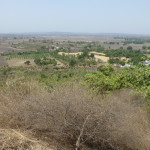
Atop a huge flat-top hill in Umbria sits the small town of Orvieto, a beautiful site full of medieval buildings still being used for public purposes. At the center of town glows the most magnificent church in white and black marble, a World Heritage monument still resplendent after nearly a thousand years. On its facade are carved myriad scenes from the Old and New Testament in intricate detail and engaging drama.
Halfway around the globe in Australia, at another World Heritage site called Kakadu, indigenous tribes from tens of thousands of years ago adorned the walls of caves with art. They too were celebrating the important things in their lives, the animals they hunted or the fish they caught, as well as stories that defined their morality.
We have been privileged to see both of these in our travels, but we now have seen their like in the most unlikely place, two towns within 50 kilometers of Bhopal.
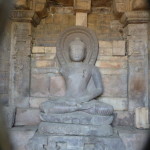
The area around Bhopal has known good times, blessed with fertile grounds, waterways and good biodiversity. And it had the good fortune to be where the venerated Mauryan Dynastic king Ashoka found a wife and, in due appreciation, founded a Buddhist pilgrimage site at Sanchi in the third century BC.
Afterwards, Bhopal appears to have prospered for a while in the 19th century under the Mughals, becoming a Muslim center of religion and commerce, to which the time-worn Islamic architecture at the heart of the city attests. Since then, it has not been quite so well off, though to its immediate south lies a busy, sprawling industrial area whose roads are clogged with trucks. To most westerners, Bhopal is instead notorious for the massive, lethal explosion at a pesticide plant thirty years ago. The toxic gas released killed up to 25,000 people over time and harmed many thousands of others.
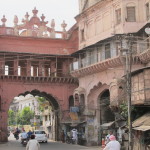
As we drove around Bhopal, we could see that some good times were back. Upmarket shopping areas and even fancy malls have come to parts of town, with more obviously wealthy areas to the east and southeast. New housing developments, like the enormous, swanky Aryavrat British Park at the far edge of the city, shows there is money being made here. For us, that wealth was underscored by a business group of well-heeled professionals who had gathered after Friday work in the lobby of our hotel for some chai and conversation.
But a foreigner visiting Bhopal comes to see the old glories, its two World Heritage sites at Sanchi and Bhimbetka, and truly splendid they are. This post tells more about Sanchi; part two tells about Bhimbetka.
Sanchi, forty kilometers of so northeast, was where Ashoka built the temple in homage to his wife – and Buddha. He placed it atop the highest flat-topped mountain in the area, a spot closer to heaven with vistas extending into the haze far off.
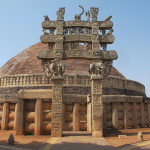
For at least eight hundred years, this center for learning and prayer grew and prospered so that it eventually offered pilgrims many temples, monastic spaces and the crowning glory of the Great Stupa for prayer. In succeeding years, however, as Hinduism pushed out Buddhism and then Islam reigned, the buildings at Sanchi disappeared into the forest.
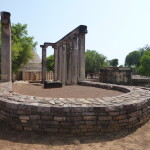
Rediscovered in the 19th century, then pillaged, it’s remarkable that any part of it remains for us to see today. Thankfully, good fortune and deft restoration have left us some of the buildings at the site and the layout of others.
More importantly, the extraordinary friezes and carvings in sandstone on the four ceremonial gateways around the main stupa or temple stand about as tall as they ever have. These are the rivals of those Biblical friezes in Orvieto, at the church high atop the Italian plains, though dating from over 1200 years earlier. They come from the period of the Satavahanas, when the art of sculpting in stone clearly flourished, as we learned in our trip to the National Museum in Delhi.
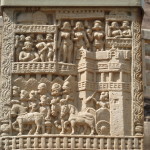
To see Sanchi’s beautiful, intricate work n a museum would hardly be surprising. To find it in such good condition, though still exposed to pollution and rain, is a bit of a miracle.
After the usual tourist rituals – purchase the ticket at the ramshackle booth (ten times the cost of an Indian resident; no, we cannot change a large bill), head to the entry gate and security (here, just a quick bag check) – we then finish the ascent to the dominant structure, the Great Stupa.
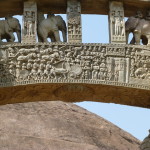
We had read about the gates around the main stupa, but hadn’t quite pictured in our minds what we were about to experience. As we approached, we could see the great dome of the stupa, a hemisphere over 16 meters tall, symbolic of Buddha’s release from earthly bounds. To its left, another domed stupa seemed to rival it in size, but proved to be a lot smaller as we got closer.
We could just see the north gate popping out against the dome’s current pastiche of brick and coating, the detail of the gate coming alive even from a distance. This gate – as well as each of the three at the other points of the compass – comprises two tall pillars connected by three arched bridges near the top. Up close, its two pillars came alive with a profusion of carved figures and processions all over the cross sections, on the four lower panels facing us, and on more panels facing inward.
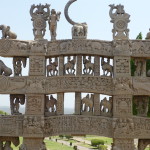
The stories told on these four gates center on the life of Buddha. We’ve become familiar with some of these stories, but there are many we do not recognize, even with them briefly encapsulated in English by a few explanatory panels. But, meaning no offense, nirvana is in the details – the wealth of people, animals, buildings in the fully sculpted bridge sections as well as the panels; the drama and emotion caught in stone at the important moments selected for the panels; the small but insightful reactions around the central motifs; the decorative touches throughout.
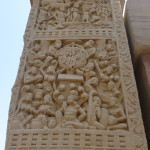
Amidst all this abundance, our favorites where those where people were caught up in emotion, like the panel with dozens of women, each seemingly particularized by their expressions of joy and astonishment.
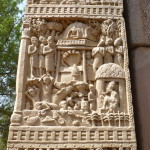
Or the panel whose lower left portion showed a few people and animals seemingly bound in anguish to their earthly existence while Buddha transcends it all.
Even when we could understand some of the richness of the story in a panel, we could be distracted by seemingly decorative touches that enhanced the central story as in the figures below those earth-bound souls.
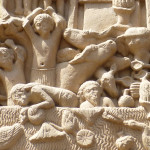
With so much to look at, we could still only appreciate bits and pieces of course, just as we did before the equally intricate carvings of the Hindu temple at Banteay Srei in Cambodia (Click here to read the post). Once again, we came away thrilled in a child-like wonder at the delight to our eyes.
(Click here to read Part 2 about the more ancient treasures at Bhimbetka.)
(Also, for more pictures from India, CLICK HERE to view the slideshow at the end of the India itinerary page.)


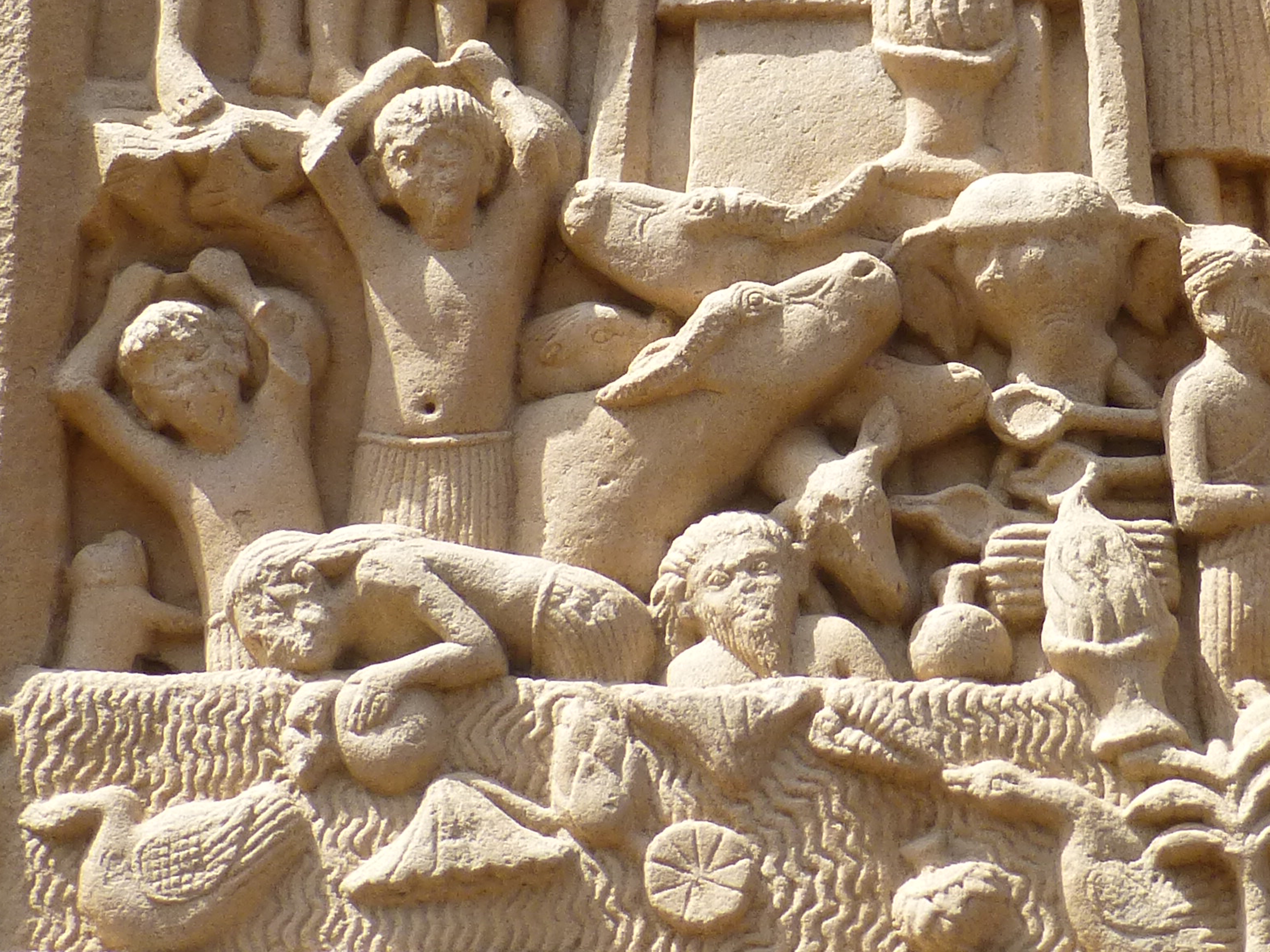
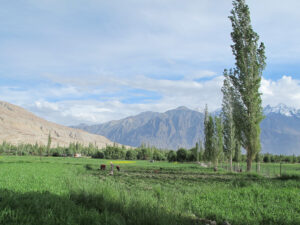
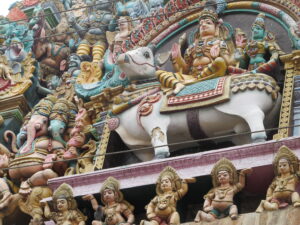
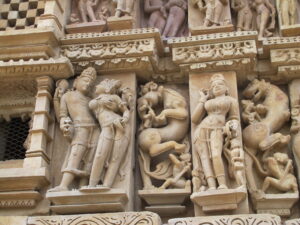
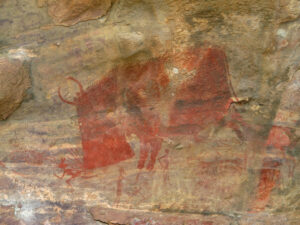
Jealous, I never made it here!